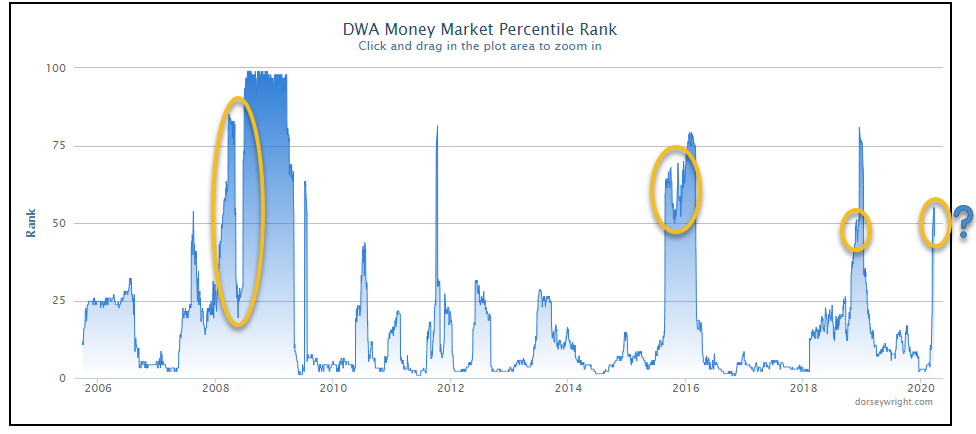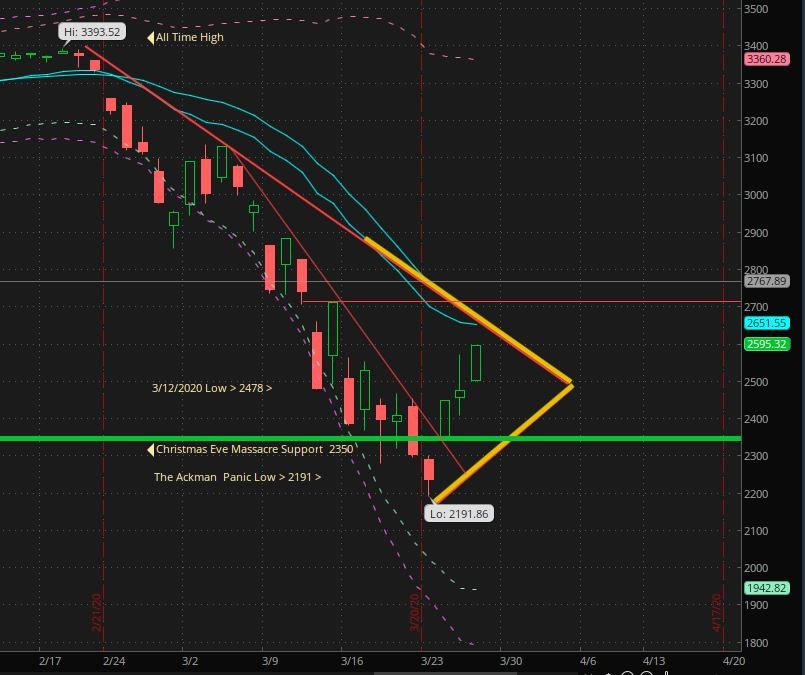At Pulliam Family Office, we measure risk. We use metrics to determine the context of the market. While most executives can stomach the volatility associated with a correction (0-20% market correction), when a trend change occurs (greater than 20% market correction), we need risk metrics that can help us protect your capital.
One of those important risk metrics is the money market percentile rank.
Consider the below insights provided by investment advisory firm Nasdaq Dorsey Wright at the start of the month:
Money Market Percentile Rank
Markets have continued their volatile movements over the past week, with intense declines last week being replaced by what looks to be three consecutive days of gains for the S&P 500 Index SPX, at least through intraday trading on Thursday. These advances have led the Money Market Percentile Rank from a level of 54.93% following movement Monday to a reading of 45.77% following action on Wednesday. While it is certainly a positive sign to see money market cross back below the 50% level, it should be noted that money market would not need to beat all too many groups to move back into the top half of rankings. It is also important to view the historical picture of the money market percentile rank reading to offer perspective on what we might expect in the weeks to come. For comparative purposes, we will take a look at the prior three times where money market moved into an elevated percentile rank for a prolonged period of time, namely 2018, 2016, and 2008. During each of these periods, the money market percentile rank advanced to elevated levels above 50% rather quickly but pulled back from these levels before continuing higher to its ultimate high ranking.
Each market environment is certainly unique, and these pullbacks from high percentile rank levels had differing levels of descent. The consistent theme, however, is that the money market percentile rank will often not reach its ultimate high on the initial spike upwards. While the near-term strength for broader equities that have been displayed over the past few days is most definitely positive improvement, we should be aware that the downtick for the money market percentile rank reading does not mean the difficulty is behind us.




The Sticks on the SPX show the current bottom trade at 2191. This 2200 level is 150 S&P points below the 2018 massacre and like that event, this bottom should hold if there are no unforeseen pieces of data in the near future. Price action out of this hole is forthright and there is still some headroom before we see a challenge at the 2700ish level. There, we will see what happens, perhaps a pause, perhaps something else. In any case, use market strength to get your allocation where you want that to be.




The “Talking Down The Market” play has certainly been prevalent over the past few weeks from certain “big-name” fund managers. In some cases, you have absolutely outstanding execution of a theatrical scaring of the world, potentially aiding to the market plunge, before turning around and making an incredible buy-side killing. Keep this in mind while listening to any “talking-heads” that may attempt to deviate you from your gameplan.
As for the rest of us, “Run” the current play in your plan and we will get to the longer-term read as the indicators adjust. Things move fast in these modes of markets, so you should keep daily tabs on the progress of things and adjust your action to adapt if need be.
To craft a disciplined approach to your asset management, schedule an appointment with Pulliam Family Office — and to learn more about Nasdaq Dorsey Wright, click here.
The attached research DJIA research report was prepared and published by a third party, and is being provided to you by Raymond James Financial Services, Inc. solely for informative purposes. Any person receiving this report from Raymond James Financial Services Inc. and/or its affiliates should direct all questions and requests for additional information to their financial advisors and may not contact any analyst or representative of the third-party research provider. Neither Raymond James Financial Services, Inc. nor any third-party research provider is responsible for any action or inaction you may take as a result of reviewing this report or for the consequences of said action or inaction.
Any information is not a complete summary or statement of all available data necessary for making an investment decision and does not constitute a recommendation. Past performance is not a guarantee of future results.
The Dow Jones Industrial Average (DJIA), commonly known as “The Dow” is an index representing 30 stock of companies maintained and reviewed by the editors of the Wall Street Journal.
The S&P 500 is an unmanaged index of 500 widely held stocks that is generally considered representative of the U.S. stock market.
The NASDAQ-100 (^NDX) is a stock market index made up of 103 equity securities issued by 100 of the largest non-financial companies listed on the NASDAQ. It is a modified capitalization-weighted index. … It is based on exchange, and it is not an index of U.S.-based companies.






